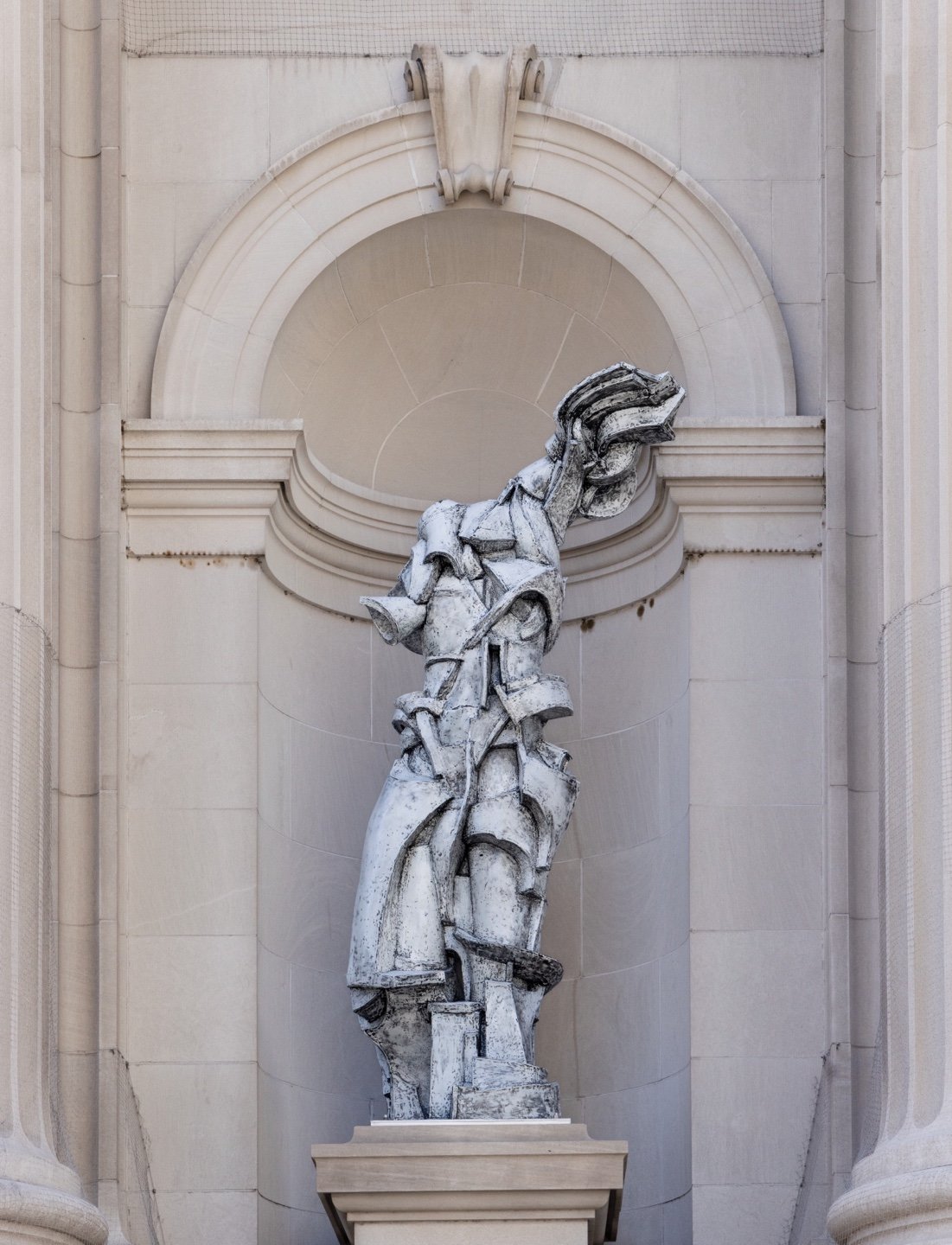
As of this month, four otherworldly sculptures by South Korea’s most infamous artist watch over Fifth Avenue from the niches along the Metropolitan Museum of Art’s forward-facing exterior, marking the first major U.S. showcase by Lee Bul in over 20 years. Their silhouettes both contradict and complement the Met’s limestone Beaux-Arts facade, enticing viewers to contemplate the catch-22 of progress.
“I can’t really speak for other institutions,” said Lesley Ma, the Met’s first-ever curator of modern and contemporary Asian art, who helped oversee Lee’s commission, Long Tail Halo. “But the reason that we chose her is that she’s one of the most celebrated sculptors of her generation.”
“Later, I found out that she knew about the facade commission,” Ma added, “and was hoping that she would be invited one day.”
The Met, featuring four new sculptures by Lee Bul. Photo by Eugenia Burnett Tinsley. Courtesy of the Metropolitan Museum of Art.
Lee, 60, achieved notoriety during her twenties for performances like Sorry for Suffering – You think I’m a puppy on a picnic (ca. 1980s–90s) and Abortion (1989), wherein she traipsed Seoul in a tentacled costume and hung from the ceiling of Dongsoong Art Center discussing her own terminated pregnancy, respectively. The latter stunt only concluded after attendees insisted Lee be taken down from her harness, which was causing her obvious pain.
From there, Lee moved into sculptures, like Majestic Splendor—a frequently re-staged installation of bagged fish that filled the MoMA with a putrid odor in 1997 debut—and her Cyborgs of the same decade, which explored the tensions between people and technology through partial, pristine, sexy half robots made from silicone, polyurethane, and paint.
Lee Bul, CTCS #1 (2024). Photo by Eugenia BurnettTinsley. Courtesy of the Metropolitan Museum of Art.
“In the mid 2010s she kind of shifted her perspective into the larger narration of history,” Ma noted. Lee’s sculptures exploded into her now-recognizable style of meticulous, many-faceted amalgamations. Her “Secret Sharer” series, which translates the shape of man’s cross-cultural best friend through this approach, debuted at her 2011 retrospective in Tokyo. Canines surface twice in her latest commission for the Met, too.
Long Tail Halo is the fifth installment in the Museum’s facade series, which Wangechi Mutu inaugurated in 2019. Lee’s edition is the first since auto company Genesis started sponsoring it. Much like Mutu and British-Guyanaese artist Hew Locke, Lee drew inspiration directly from the Met’s collection for her turn in the niches. But, instead of putting a new spin on the past or interrogating the present, Lee looks towards the future.
Lee Bul, The Secret Sharer II (2024). Photo by Eugenia BurnettTinsley. Courtesy of the Metropolitan Museum of Art.
Two different shapes appear here: two proud humanoid forms, and two crouching canines. The taller figures flank the Met’s doors, while the dazzling dogs perch on the outskirts, purging crystals into the fountains—a serendipitous alignment that even Lee didn’t foresee, according to Ma.
All four sculptures tessellate mesmerizing planes of EVA or polycarbonate parts over steel armatures. Although the niches do offer a bit of protection from the elements, it helps that Lee has built a practice off such durable, industrial materials. And while scores of artists typically send the designs for their public artworks out for fabrication, Lee handcrafted these sculptures with the help of about a dozen assistants in her Seoul studio, piecing them together atop underlying skeletons of woven stainless steel that resemble artworks in their own right, if only viewers could see them.
Umberto Boccioni, Unique Forms of Continuity in Space, conceived in 1913, cast in 1972. Courtesy of Christie’s Images Ltd.
During the day and a half-long Met visit that kickstarted Lee’s conceptualization, she was struck by the Cubist works of Pablo Picasso and Fernand Leger, as well as Umberto Boccioni’s Futurist bronze sculpture Unique Forms of Continuity in Space (1913). A show of Louise Bourgeois’s oft-overlooked paintings depicting human forms arising from architectures—much like Lee blends the figurative with the abstract, and the human with the non human—also struck her.
These disparate artistic influences clearly manifest amongst Long Tail Halo. Mixed together, though, they blend into a classical beauty that, at times, echoes the likes of Lady Liberty.
Long Tail Halo encompasses Lee’s fortes—her command over material, her taste for allure, and her ability to toe the line between utopia and dystopia. Their striking appearance invites guests and pedestrians alike to slow down, take a closer look, and perhaps even pause for a second thought, before returning to progress’s inexorable pull.
“Lee Bul: Long Tail Halo” is on view at the Metropolitan Museum of Art, 1000 5th Ave, New York, through May 27, 2025.